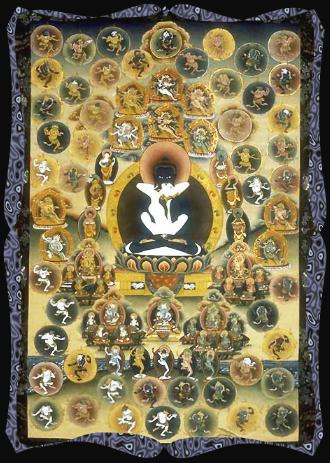to create reverence for life
to show that we are accountable for all our actions, words and thoughts
to show that death is not the end, but also the beginning of life
to create a mass media global marketing of an enlightening message in a commercial entertaining and at times humorous
trans-cultural, trans-religious, trans-racial vessel
to uplift, to give hope and bring one closer to God
THE TIBETAN BOOK OF THE DEAD
Bardo Thotrol (Bar-do’i-thos-grol) in Tibetan or more commonly known as “The Tibetan Book of the Dead”, is a classic of the world’s religious literature. It concerns the nature of the mind and its projections – beautiful or terrible, peaceful and wrathful – which seem to exist objectively and inhabit the external world. In particular it describes these projections as they appear immediately after death, in a much more overwhelming form since the consciousness is no longer grounded and shielded by its connection with a physical body. It teaches recognition of these terrifying and seductive forms, and through recognition attainment of the state of enlightenment. This centuries-old scripture was traditionally read aloud to the dying to help them attain liberation – death and rebirth as seen as a process that offers the possibility of attaining ultimate liberation.
Bardo means gap. It is not only the interval of suspension after we die but also suspension in the living situation. According to the Tibetans, death happens in the living situation as well. The bardo experience is part of our basic psychological make-up. The book is not only a message for those who are going to die and those who are already dead, but it is also a message for those who are already born: birth and death apply to everybody constantly, at this very moment.
I was exposed to the book as a teenager when were in India and visited Nepal. The sound of the Tibetan dunchen horns emanating from the Buddhist Temples got me hooked. Since then it has been my dream to make it into a film. Originally when I was at MIT I developed an outline and enlisted the writer William Burroughs to write the screenplay and composer Philip Glass to score the film. I am grateful the film never came to pass as I was not ready. The current screenplay was written by Star Trek TV series writer Herbert J. Wright, who recently passed away due to cancer. It was his dream as well as mine to make it into a film. I made a promise not to let him down…
I hounded down the Dalai Lama, stopped him in his tracks, and handed him the script in a brown envelope “Your Holiness, I want to make this script into a movie for the whole world to see, it is a Hollywood version of the Tibetan Book of the Dead. Will you please bless it?” He looked into my eyes, bowed and did not say a word, but smiled….”
[slideshow_deploy id=’1937′]
A note about Herb J. Wright
As a high school exchange student in Japan, Herbert Wright began a lifelong study of martial arts, and the art of filmmaking after meeting the legendary director, Akira Kurosawa. After graduation with honors from Yale, filmmaker Wright moved to Hollywood, pursuing a successful career in movies and TV. Wright worked as a producer-writer-director on hit shows such as “Star Trek: The Next Generation” (1987), “War of the Worlds” (1988), “Hunter” (1984), and “Stingray” (1986), amassing over 200 episodes produced. Trekkies know of the Emmy-nominated Wright as the “Father of the Ferengi”, having created the notorious space villains at Gene Roddenberry’s bidding. He produced, wrote and directed the first original made-for-the-Net Science Fiction entertainment, the sci-fi cyberseries Mars and Beyond (2000), on the Cyber Sci-Fi Network. In body, he is no longer with us, however…
